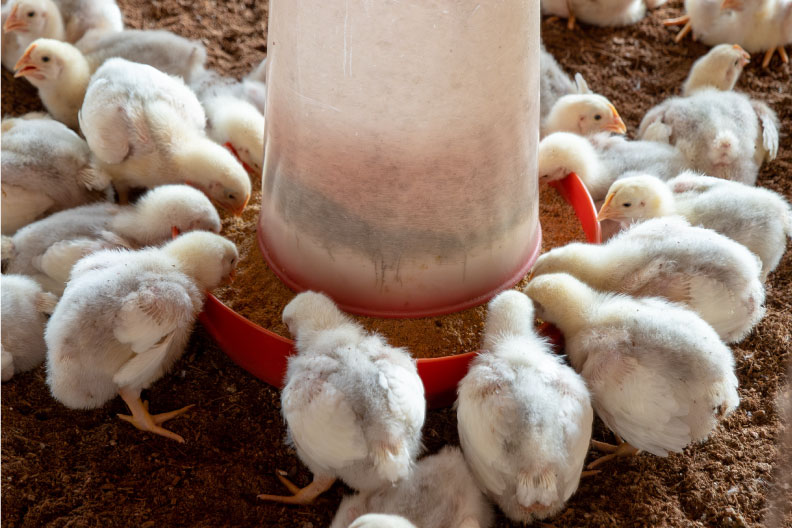By Ryan Snyder
Poultry Production Improvement Specialist
Grand Valley Fortifiers
These pathogens are different from viruses and bacteria in how they replicate and transmit from bird to bird. They have a strange life cycle that requires an environmental stage. The cocci essentially leave the chicken to undergo their environmental stage for a day or two before being picked up by the next chicken. Transmission occurs when the fecal material of an infected bird is ingested by another. Let us not forget that broilers have access to their droppings, and natural chicken behaviour includes foraging by ground pecking, which accelerates transmission of cocci from bird to bird in a barn. The severity of disease depends on the exposure to the cocci: the more exposure, the bigger the impact (except when drugs or immunity is present).
The estimated annual burden of coccidiosis to the global poultry industry is 3 billion USD due to the costs of disease prevention and treatment, and reductions in production including mortality and poorer feed conversion. Thankfully, the pharmaceutical industry has developed many products to help control the impact of these parasites. For decades, these compounds have eliminated the threat of coccidiosis from poultry production. There is no doubt that the poultry industry would not be as successful as it is today without the discovery and use of these products. These anticoccidial medications, or coccidiostats, are classified as either chemicals or ionophores. Unfortunately, the effectiveness of coccidiostats is not what it used to be. Although shuttle and rotation programs have been employed, there has still been an over-usage of these products that has led to the development of drug resistant Eimeria species. This drug-resistance tends to be specific to a farm and a product, based on the history of anticoccidial usage at a facility. However, multidrug resistant cocci have been detected at some facilities. Therefore, regular testing to determine which products are effective will optimize the coccidiosis control program.
Alternatively, a live-coccidiosis vaccine can be used to prevent disease. First developed in the 1950s, the vaccine was more popular in longer-lived poultry such as layers and breeders, who had more time to recover from adverse effects of the vaccine. Coccidiosis-vaccines for broilers has become more popular over the last 2 decades as anticoccidial medication effectiveness has declined, and the demand for chicken to be antibiotic free has grown. In Canada, the vaccines we have available are live cocci parasites which is necessary for the chicks to develop immunity, however, may cause some damage to the gut. Some vaccines included cocci strains that have been modified (attenuated) to have less impact on the chick while still allowing the chicken to develop immunity. The vaccine is applied to day-of-hatch chicks at the hatchery by applying the vaccine on top of a box of chicks for them to preen off each other. For the chicken to be protected from a severe cocci challenge, it needs to be exposed more than once, like a vaccine booster. A farmer can promote multiple exposures by allowing the cocci to cycle in the barn.
Each cycle is about one week, and it can take up to 3 or 4 cycles for a flock to be protected. The barn environment must be maintained properly, typically with increased humidity, to allow the cocci to cycle. If the cycling is prematurely halted, the chickens will not develop immunity and be at risk for an outbreak later in production. Cocci vaccines typically include only the Eimeria species that are observed in that type of production. For instance, breeders and layers are vaccinated for Eimeria brunetti and Eimeria necatrix (among others), whereas broilers do not need protection from these cocci.
New in-feed alternatives are continuously researched and developed around the globe as a replacement for antibiotics and anticoccidial medications, but no “silver-bullet” has been found. Some of these technologies can be used alone, or in combination with other in-feed products or the cocci- vaccine. An annual rotation between anticoccidials and cocci- vaccine can help reduce anticoccidial resistance therefore improving drug effectiveness in flocks after the vaccine. Alternatively, a bio-shuttle program uses both a live-vaccine followed by an anticoccidial for roughly 10-14 days starting around the second week. This program allows the flock to develop immunity while reducing any negative impact of the cocci during the peak challenge period.
Coccidiosis remains a significant threat to poultry production. From the gut health perspective, understanding and controlling cocci becomes even more important when other diseases, such as necrotic enteritis come into play. Gut health is pivotal to the success of antibiotic free production as the broiler industry changes. Grand Valley Fortifiers is continuously investigating new products and technologies aimed at optimizing nutrition and gut health that poultry need for our customers to be successful.
This article was written for the Fall 2020 Poultry Grist. To read the whole Poultry Grist, click the button below.

